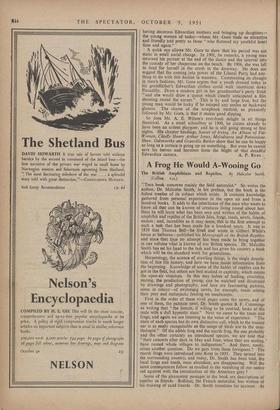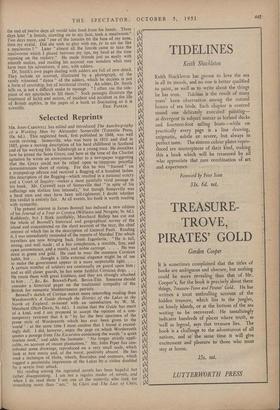A Frog He Would A-Wooing Go
The British Amphibians and Reptiles. By Malcolm Smith. (Collins. 219.) "THIS book concerns mainly the field naturalist." So writes the author, Dr. Malcolm Smith, in his preface, but the book is the fullest treatise of its subject which exists. It contains knowledge gathered from personal experience in the open air and from a hundred books. It adds to the inheritance of the man who wants to know all that can be known of creatures living round about him. Here he will learn what has been seen and written of the habits of amphibia and reptiles of the British Isles, frogs, toads, newts, lizards, snakes ; and, incredible as it may seem, this is the first attempt at such a task that has been made for a hundred years. It was in 1839 that Thomas Bell—he lived and wrote in Gilbert White's house at Selborne—published his Monograph of the British Reptiles, and since that time no attempt has been made to bring together in one volume what is known of our British species. Dr. Malcolm Smith has set his hand to the task and has given his country a book which will be the standard work for generations.
Herpetology, the science of crawling things, is the single descrip- tion of this life history, and here we have inside information from the beginning. Knowledge of some of the habits of reptiles can be got in the field, but others are best studied in captivity, which means the open-air vivarium. In this way habits of feeding, courtship, mating, the production of young, can be watched and illustrated by drawings and photography, and here are fascinating pictures, some in colour—of swimming newts, for example, toads seizing their prey and natterjacks feeding on mealworms.
First in the order of these vivid pages come the newts, and of one of them, the palmate newt, Dr. Smith quotes B. F. Cummings as writing that "the female, if willing to be courted, looks at the male with a dull hypnotic stare." Next we come to the toads and frogs, and again we are listening to the voice of experience. "The male of each species has its own distinctive call, which to the trained ear is as easily recognisable as the songs of birds are to the orni- thologist." Of the edible frog and the marsh frog, the one probably and the other certainly an introduced species, we are told that "their concerts after dark in May and June, when they are mating, ' have roused whole villages to indignation." And there, surely, arises another question. Do we gain from these foreigners ? The marsh frogs were introduced into Kent in 1935. They spread into the surrounding country, and today, Dr. Smith has been told, the local frogs and toads, once abundant, are disappearing. Will the same consequences follow as resulted in the vanishing of our native red squirrel with the introduction of the American grey ?
Some of the pleasantest passages in the book are descriptions of reptiles as friends. Rollinat, the French naturalist, has written of his training of sand lizards. Dr. Smith translates his account. At
the end of ;twelve days all would take food from his hands. Three days later "a female, crawling on to my face, took a mealworm." Two days more, and "one of the females bit the base of my nose, then my eyelid. Did she wish to play with me, or to eat me like a mealworm 7 " Later "almost all the lizards came to take the mealworms which I placed between my lips, my head at the time reposing on the rockery." He made friends just as easily with smooth snakes, and reading his account one wonders what may have been his adventures, if any, with adders.
Dr. Smith's own pages dealing with adders are full of new detail. They include an account, illustrated by a photograph, of the rarely. witnessed " dance " of the adders, which he decides is not a ,form of courtship, but of territorial rivalry. An adder, Dr. Smith tells us, is not a difficult snake to manage. "I often use the side- piece of my spectacles to lift them." Such passages illustrate the treatment of habit and nature, of incident and accident in the life of British reptiles, in the pages of a book as fascinating as it is
scientific. ERIC PARKER.






















































 Previous page
Previous page